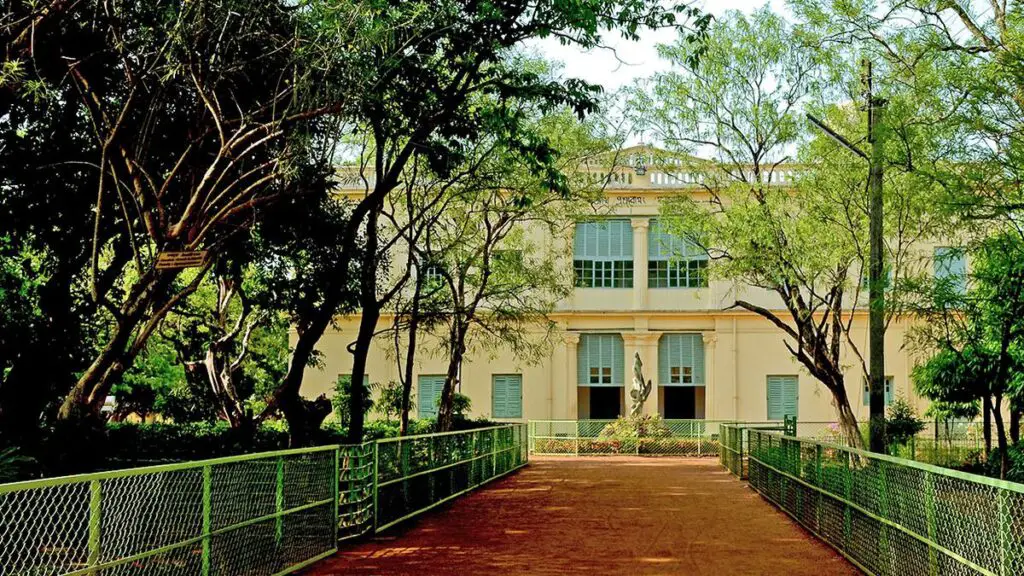Santiniketan, the abode of peace of Gurudev Rabindranath Tagore, has recently become a part of UNESCO’s World Heritage List. Located in West Bengal’s Birbhum district, Santiniketan is a cultural landmark that celebrates the harmonious relationship between nature and the arts.
The history of Santiniketan is intriguing. In 1863, Maharshi Devedranath Tagore, the father of Rabindranath Tagore, was captivated by the beauty and tranquility of the area while passing through it. He decided to purchase 20 bighas of land from the zamindar Bhubanmohan Sinha of Raipur in Birbhum district. At the time, the area was known as Bhuvandanga and was infested with dacoits.
Maharshi Devedranath Tagore, who was a philosopher, socio-religious reformer, and leader of the Brahmo Samaj, worked hard to bring peace to the area. He succeeded in transforming the dacoits and reintegrating them into society. Inspired by their transformation, they collaborated to build a prayer hall in Santiniketan. The unique design of the prayer hall included tinted glass walls, with a 60ft length, 30ft width, tiled roof, and marbled floor. Maharshi Devedranath Tagore named it Santiniketan, meaning “abode of peace.”
The ancestral house of Maharshi Devedranath Tagore, Jorasanko Thakurbari in Calcutta, was a bustling hub of cultural activities. It hosted music events, plays, poetry and painting sessions, and even discussions on textiles. The Tagore family, known for their wealth, intellect, and aesthetic sensibilities, made significant contributions to the enrichment of Bengal’s life and society.
Rabindranath Tagore, the youngest of the 14 children of Maharshi Devedranath Tagore and Sarada Devi, was introduced to the Upanishads, literature, and music at a young age. Encouraged by his father, Rabindranath started writing and composing devotional songs in his early teens. He would sing these songs at Brahmo-Samaj congregations. Rabindranath once said, “To me, the verses of the Upanishads and the teachings of Buddha have ever been things of the spirit and therefore endowed with boundless vital growth, and I have used them both in my own life and in my preaching.”
At the age of 17 in 1887, Rabindranath stepped foot in his father’s Santiniketan. He was enchanted by its serene ambiance. It was in Santiniketan that Rabindranath came into contact with the mystic Bauls and became familiar with Kabir’s philosophy. Their influence played a significant role in shaping his thoughts and ideas.
Despite his accomplishments as a poet, lyricist, music composer, storywriter, novelist, playwright, performer, and orator, Rabindranath had a deep desire to teach. He inherited his father’s compassionate nature and felt compelled to educate the masses and introduce them to the wisdom of ancient Indian scriptures. To fulfill this vision, he needed a suitable place away from the chaos of city life.
In 1901, Rabindranath decided to establish a school, initially called Brahmacharyaashram and later renamed Patha Bhavana in 1925, in Santiniketan. The school embraced the ancient guru-shishya (teacher-student) tradition. Rabindranath’s enlightened and affluent family supported his vision. The school grew rapidly, attracting learned teachers from all over the country, especially after Rabindranath’s global fame as the first Asian Nobel Laureate. Both Jawaharlal Nehru and Mahatma Gandhi became admirers of Rabindranath.
Within two years, Rabindranath was knighted by the British government. However, in protest against the Jallianwala Bagh massacre, he returned the Knighthood. Rabindranath had become a symbol of Indian spirituality and traveled around the world, delivering friendly lectures. Despite his busy schedule, he took great care to preserve the natural beauty of Santiniketan. He wanted to create an environment that would inspire students and stimulate their minds. He emphasized the importance of imagination, alertness, and curiosity in a child’s growth. He taught the students to appreciate the simple pleasures of life.
Rabindranath also prioritized the physical well-being of the students and introduced yoga, sports, and dance, despite societal taboos. He organized events like Poush Mela, Nandan Mela, Vriksharopan (tree plantation), and Halakarshan (ploughing fields) to promote agricultural festivities. He transformed the Varsha and Basant utsavs by infusing them with his Rabindrasangeet (songs composed by Rabindranath), drawing inspiration from Hindustani, Carnatic, and Western music. He also created Rabindric dance, a fusion of Manipuri, Kathakali, Kathak, and Western dance styles.
The success story of Santiniketan is not without its share of sorrow. Shortly after moving to Santiniketan, Rabindranath lost his wife, Mrinalini Devi. Two years later, his 13-year-old daughter, Renuka, passed away. Despite the immense pain he felt, Rabindranath remained stoic. However, he was shattered when his youngest son, Shamindranath, also died. Many of Rabindranath’s songs from this period reflect his profound grief. His second daughter, Mira, and elder son, Rathindranath, along with his second wife, Pratima, provided him with constant support.
In 1921, at the age of 60, Rabindranath laid the foundation of Visva Bharati, an international university. He nurtured it until his last breath in 1941. Under his guidance, Visva Bharati became a central university of national importance in 1951. Today, Santiniketan and Visva Bharati are cherished as symbols of Rabindranath’s vision and continue to inspire generations of students and scholars.
In conclusion, the historic and culturally significant Santiniketan has rightfully earned its place on UNESCO’s World Heritage List. The legacy of Rabindranath Tagore and his vision of harmonizing nature and arts continue to thrive in this serene abode of peace.

